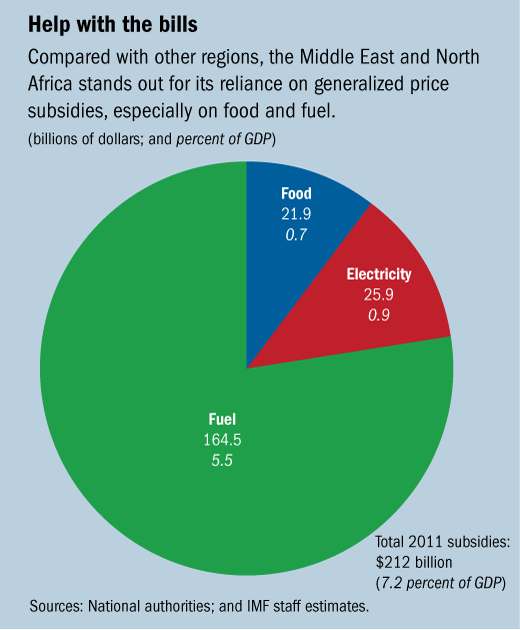
Typical street scene in Santa Ana, El Salvador. (Photo: iStock)
IMF Survey: Costly Mideast Subsidies Need Better Targeting
May 14, 2012
- Generalized price subsidies are often costly, inefficient
- Targeted social safety nets give better support, allow more priority spending
- Subsidy reform should be among steps to cut poverty, boost inclusive growth
Many governments across the Middle East and North Africa (MENA) provide substantial energy and food price subsidies to their populations to offer some relief from high commodity prices or to share the wealth from natural resources.

Gas station in Cairo, Egypt, where overall food, fuel subsidies accounted for more than 8 percent of GDP in 2011 (photo: Khaled Elfiqi/EPA)
MIDDLE EAST AND NORTH AFRICA
These well-intended social protection policies are increasingly weighing on government budgets and debt levels and are not necessarily the most efficient way to channel aid to the most vulnerable, participants at a recent IMF seminar said.
The unprecedented social and political transitions under way in many countries of the region underscore the widespread desire to shift away from the status quo and to embrace new socioeconomic policies. “For political transition to be successful, the economic underpinnings have to be strong…and we would be dishonest if we pretend that the current economic strategies are going to deliver on the hopes of those young people who sacrificed for change to come,” said Nemat Shafik, IMF Deputy Managing Director.
At a seminar held last month on the sidelines of the 2012 IMF–World Bank Spring Meetings in Washington, DC, and moderated by Al-Jazeera, panelists discussed the experience of countries from the region and beyond in reforming subsidies, which in the MENA region are both unsustainably costly and inefficient. Panelists considered how governments can address the challenges of phasing out universal price subsidies and introducing more targeted forms of social protection.
Costly endeavor with limited benefit
Compared with other regions, MENA stands out because of its heavy reliance on generalized price subsidies, especially on food and fuel. The IMF’s Middle East and Central Asia department estimates the cost of subsidies at about $212 billion in 2011, or over 7 percent of regional GDP, of which about 80 percent reflect fuel subsidies (see chart).

According to the International Energy Agency, the MENA region accounted for almost two-thirds of petroleum price subsidies worldwide in 2009. “Most of the price subsidies in the world are in this region…as many countries elsewhere have abandoned price subsides and moved to better systems of social protection,” Shafik said.
Oil-exporting countries fare the worst, since cheap fuel is seen as an entitlement in light of the natural resource wealth of these countries. While the region’s oil importers, in general, do better, estimates show that subsidies still represent a fiscal challenge; for example, IMF estimates show that overall food and fuel subsidies accounted for more than 8 percent of GDP in Egypt and Jordan in 2011.
Social safety net instruments, which better target the poor, and social insurance play less of a role in the region. In particular, cash transfers and other forms of direct income support are not used widely and, where they exist, are underfunded.
Across MENA, generalized price subsidies are not very effective in helping the poor, who end up receiving a relatively small portion of spending on subsidies. “It’s a myth that generalized energy subsidies could help the poor…as only 20 percent of those subsidies reach the poor while the remaining 80 percent benefit the non-needy,” said Shafik. In agreement with Shafik, Umayya Toukan, Jordan’s Minister of Finance said, “the current blanket system of subsidies does not serve its purpose as the majority of the subsidies go to the rich.”
The alternative
There was consensus among panelists on the need to replace wasteful price subsidy regimes that benefit mostly the wealthy with targeted social safety nets that better protect the poor. Social safety nets are more cost effective, they concurred, and thus leave more fiscal resources for other priority spending such as investment in infrastructure, education, and health, which would benefit populations at large. Relative to the more than 8 percent of GDP that Jordan, for example, spent on subsidies in 2011, only 1.4 percent of GDP was budgeted for investment in health and education.
José Antonio González Anaya, Mexico’s Undersecretary of Finance, agreed with other panelists that reforming the system of generalized subsidies is “inevitable.” According to Anaya, “Mexico is spending a significant amount of the budget on the poor, but not in a generalized fashion.”
Social safety nets have a much more profound impact than do generalized price subsidies. For example, IMF estimates indicate that well designed cash transfer systems in MENA can typically result in about 50–75 percent of spending reaching the bottom 40 percent of the population, compared with 20 percent of the amount spent to subsidize fuel prices and 35 percent to subsidize food prices.
Country experience
Many countries rely on targeting by social category, such as limiting benefits to children or pensioners, or to households in certain geographical regions. Alternatively, coupons can be allocated to target households to allow them to consume a certain “lifeline” amount of subsidized food or fuel products.
“There are many ways to target the poor, either by subsidizing the goods that poor people consume, targeting regions where the poor people live, or by providing lifeline tariffs and cash transfers,” said Shafik.
Jordan, for example—as part of its food subsidy reform in the early 1990s—rationed sugar, rice, and powdered milk at low, administered prices through the introduction of a coupon system.
In Mexico, the Tortivales scheme introduced in 1990 allowed urban low-income households to receive 1 kilogram of tortillas every day by using “smart” cards, issued on the basis of a means test. Later, the program was phased out and integrated into Oportunidades, a conditional cash transfer program.
In Turkey, generalized price subsidies were eliminated gradually starting in the 1980s and ending in early 2000 in the context of a broader macroeconomic adjustment agenda. “We taxed fuel very heavily and used the revenues to spend on education, health care, and cash transfers to the poor,” said Mehmet Şimşek, Turkey’s Minister of Finance.
In Iran, the government designed a cash compensation scheme to be rolled out in conjunction with a sharp rise in fuel prices. The cash transfer was originally intended for a target group composed of poor households, but was later extended to the whole population to increase the chance of success of the reform.
Impact on macro stability and growth
According to seminar participants, subsidy reform should be part of a broader economic reform strategy. They shared the notion that sound macroeconomic and structural policies are essential for sustaining growth while reducing unemployment and poverty.
Anaya stressed that no country has grown sustainably without macroeconomic stability, which requires, among other things, fiscal discipline. He said “reforming the system of price subsidies has helped Mexico grow faster than countries that still maintain the generalized subsidy regime.”
According to Şimşek, Turkey had large and chronic deficits and high debt levels in the 1990s partly because of the costly price subsidy system. Financing the fiscal deficit through central bank borrowing back then led to episodes of high inflation, which hurt the poor the most. Reforming the subsidy regime ultimately helped bring the budget deficit close to zero, reduce the debt-to-GDP ratio significantly, and provide more support to the poor.
Though current political transitions present a challenge for MENA policymakers in initiating subsidy reform, Toukan underscored that there is no alternative but to abandon the current system of price subsidies, which “causes unsustainable fiscal and current account deficits.”
Role of communication
Panelists agreed that successful subsidy reform calls for a public communications campaign that highlights the advantages of the reform, creates political momentum, and establishes realistic expectations about what can be achieved.
An important message to send to the population at large is that budgetary savings will be used for everyone’s benefit, for example, in protecting or expanding existing public spending on education, health, and infrastructure.
“Building a political consensus and public communications plan is essential in the process of gradually abolishing price subsidies,” said Shafik. Toukan added that, “It’s the responsibility of policymakers to explain to the public the implications of continuing with unsustainable system of subsidies that leads to accumulating fiscal deficits and debts.”
Şimşek underlined that reforming price subsidies might not necessarily result in a political cost as long as “it’s designed and communicated well and accompanied with alternatives, such as providing the poor with free education and health care, reducing tax rates on essential food stuff and increasing the rates on automotives and fuel consumption.”
How the IMF can help
According to Shafik, the IMF can provide technical advice and the lessons of experience from across its membership. Improving the quality of government expenditure and tackling the issue of subsidies will be critical, she said, to respond to the region’s social needs, raise investment, enhance human capital, create jobs, and reduce fiscal deficits that are increasing debt levels and crowding out lending to the private sector.


